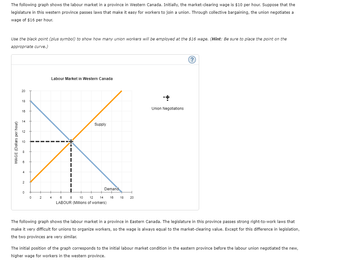
ENGR.ECONOMIC ANALYSIS
14th Edition
ISBN: 9780190931919
Author: NEWNAN
Publisher: Oxford University Press
expand_more
expand_more
format_list_bulleted
Question
no handwritten notes

Transcribed Image Text:The following graph shows the labour market in a province in Eastern Canada. The legislature in this province passes strong right-to-work laws that
make it very difficult for unions to organize workers, so the wage is always equal to the market-clearing value. Except for this difference in legislation,
the two provinces are very similar.
The initial position of the graph corresponds to the initial labour market condition in the eastern province before the labour union negotiated the new,
higher wage for workers in the western province.
Adjust the graph to show what happens to employment and wages in the eastern province after some workers in the western province lose their jobs
and decide to move to the eastern province.
WAGE
Labour Market in Eastern Canada
LABOUR
Supply
Demand
Demand
Supply
(?)

Transcribed Image Text:The following graph shows the labour market in a province in Western Canada. Initially, the market-clearing wage is $10 per hour. Suppose that the
legislature in this western province passes laws that make it easy for workers to join a union. Through collective bargaining, the union negotiates a
wage of $16 per hour.
Use the black point (plus symbol) to show how many union workers will be employed at the $16 wage. (Hint: Be sure to place the point on the
appropriate curve.)
WAGE (Dollars per hour)
20
18
16
14
12
10
2
0
0
2
Labour Market in Western Canada
4
Supply
8
Demand
6
10
12
14
LABOUR (Millions of workers)
16
18 20
+
Union Negotiations
(?)
The following graph shows the labour market in a province in Eastern Canada. The legislature in this province passes strong right-to-work laws that
make it very difficult for unions to organize workers, so the wage is always equal to the market-clearing value. Except for this difference in legislation,
the two provinces are very similar.
The initial position of the graph corresponds to the initial labour market condition in the eastern province before the labour union negotiated the new,
higher wage for workers in the western province.
Expert Solution
This question has been solved!
Explore an expertly crafted, step-by-step solution for a thorough understanding of key concepts.
Step by stepSolved in 4 steps with 4 images

Knowledge Booster
Learn more about
Need a deep-dive on the concept behind this application? Look no further. Learn more about this topic, economics and related others by exploring similar questions and additional content below.Similar questions
- Financial statements, what are they? what are they used for? Why are they important? What are the different types and the purpose of each?arrow_forwardWhat is a CD and how do they work?arrow_forwardYou are looking for a car to lease. Your income is $3,000 per month, and you know that you should not spend more than 20 percent of your income on a car payment. You have found four deals in the table below. options Location Monthly Rent Toyota Camry $400 Lincoln MKZ $660 Ford Fusion $380 BMW 740 $720 Instructions: In order to receive full credit, you must make a selection for each option. For the correct answer(s), click the box once to place a checkmark. For the incorrect answer(s), click the option twice to empty the box. Suppose you adhere to the 20 percent guideline but also receive a $100 monthly allowance from your parents towards your car payment, which option(s) fall within your budget? Group of answer choices Toyota Camry Lincoln MKZ Ford Fusion BMW 740arrow_forward
- What are some mandates and compliance regulations that protect people's identity and privacy?arrow_forwardFill in the blanksarrow_forwardYour mom recently received a new credit card statement in the mail. She paid the billonline and threw the statement away. How can she become a victim of identity theft?arrow_forward
arrow_back_ios
SEE MORE QUESTIONS
arrow_forward_ios
Recommended textbooks for you

 Principles of Economics (12th Edition)EconomicsISBN:9780134078779Author:Karl E. Case, Ray C. Fair, Sharon E. OsterPublisher:PEARSON
Principles of Economics (12th Edition)EconomicsISBN:9780134078779Author:Karl E. Case, Ray C. Fair, Sharon E. OsterPublisher:PEARSON Engineering Economy (17th Edition)EconomicsISBN:9780134870069Author:William G. Sullivan, Elin M. Wicks, C. Patrick KoellingPublisher:PEARSON
Engineering Economy (17th Edition)EconomicsISBN:9780134870069Author:William G. Sullivan, Elin M. Wicks, C. Patrick KoellingPublisher:PEARSON Principles of Economics (MindTap Course List)EconomicsISBN:9781305585126Author:N. Gregory MankiwPublisher:Cengage Learning
Principles of Economics (MindTap Course List)EconomicsISBN:9781305585126Author:N. Gregory MankiwPublisher:Cengage Learning Managerial Economics: A Problem Solving ApproachEconomicsISBN:9781337106665Author:Luke M. Froeb, Brian T. McCann, Michael R. Ward, Mike ShorPublisher:Cengage Learning
Managerial Economics: A Problem Solving ApproachEconomicsISBN:9781337106665Author:Luke M. Froeb, Brian T. McCann, Michael R. Ward, Mike ShorPublisher:Cengage Learning Managerial Economics & Business Strategy (Mcgraw-...EconomicsISBN:9781259290619Author:Michael Baye, Jeff PrincePublisher:McGraw-Hill Education
Managerial Economics & Business Strategy (Mcgraw-...EconomicsISBN:9781259290619Author:Michael Baye, Jeff PrincePublisher:McGraw-Hill Education


Principles of Economics (12th Edition)
Economics
ISBN:9780134078779
Author:Karl E. Case, Ray C. Fair, Sharon E. Oster
Publisher:PEARSON

Engineering Economy (17th Edition)
Economics
ISBN:9780134870069
Author:William G. Sullivan, Elin M. Wicks, C. Patrick Koelling
Publisher:PEARSON

Principles of Economics (MindTap Course List)
Economics
ISBN:9781305585126
Author:N. Gregory Mankiw
Publisher:Cengage Learning

Managerial Economics: A Problem Solving Approach
Economics
ISBN:9781337106665
Author:Luke M. Froeb, Brian T. McCann, Michael R. Ward, Mike Shor
Publisher:Cengage Learning

Managerial Economics & Business Strategy (Mcgraw-...
Economics
ISBN:9781259290619
Author:Michael Baye, Jeff Prince
Publisher:McGraw-Hill Education